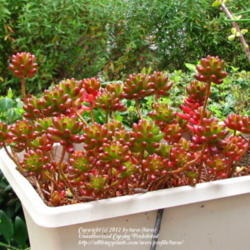
Sedums, also called stonecrop, are versatile plants. They grow well in perennial borders, containers, and rock gardens. However, it's their thick, fleshy leaves and colorful blossoms that makes them sought-after additions to any garden. And they are among the easiest of plants to propagate.
This group of succulents comes in a range of shapes and sizes, from tiny to tall. Low-growing types such as golden stonecrop (Sedum acre) and white stonecrop (S. album) form moss-like mats, making great ground covers in dry, sunny locations. They're right at home in rock gardens, where they happily fill a small niche or scramble over rocks. The taller species, such as S. maximum with greenish flowers, S. telephium with red-purple flowers, and S. sieboldii with pink flowers and blue-green leaves, are perfect accents for sunny borders. All listed here are hardy to at least USDA Zone 4.
Growing Sedums
You don't need a green thumb or hours of spare time to grow sedums. They thrive in almost any sunny site as long as the soil drainage is good. They're drought tolerant and not picky about soil fertility or pH. They're also easy to propagate, which makes them a definite favorite of mine.
I have excellent results propagating sedums by tip cuttings. All you need is a pair of pruning shears and a plastic tray or pot filled with a well-draining soil mix. I use equal parts of potting soil and sand. There's no need for rooting hormones or humidity tents.
From the tip of the stems, snip sections with three or more leaves into pieces 3 to 4 inches long. Pull off the bottom two leaves of these sections and push the cuttings into moistened soil mix so that the exposed nodes (the points where the leaves join the stem) are below the surface of the mix. The new roots will emerge from these nodes. Water the cuttings and set them in a shady place. Check the soil mix often and water enough to keep the cuttings from drying out.
Sedums generally root in about 3 weeks. You can check by gently tugging on a cutting. If you feel resistance, it has roots on the other end. Six to eight weeks after starting, cuttings are ready for transplanting. I tip the cuttings out of the pot, gently pull them apart, and plant them directly into the garden or pots.
Easiest Sedum
For gardeners new to sedums, I recommend starting with Sedum 'Ruby Glow'. It's easy to grow and widely available. The foliage is a silvery blue with reddish undertones, and in late summer it produces clusters of intensely pink-red flowers. 'Ruby Glow' grows to about 8 inches tall and is perfect as an edging plant for a perennial border.
Photograph by Patt Kasa/National Gardening Association.